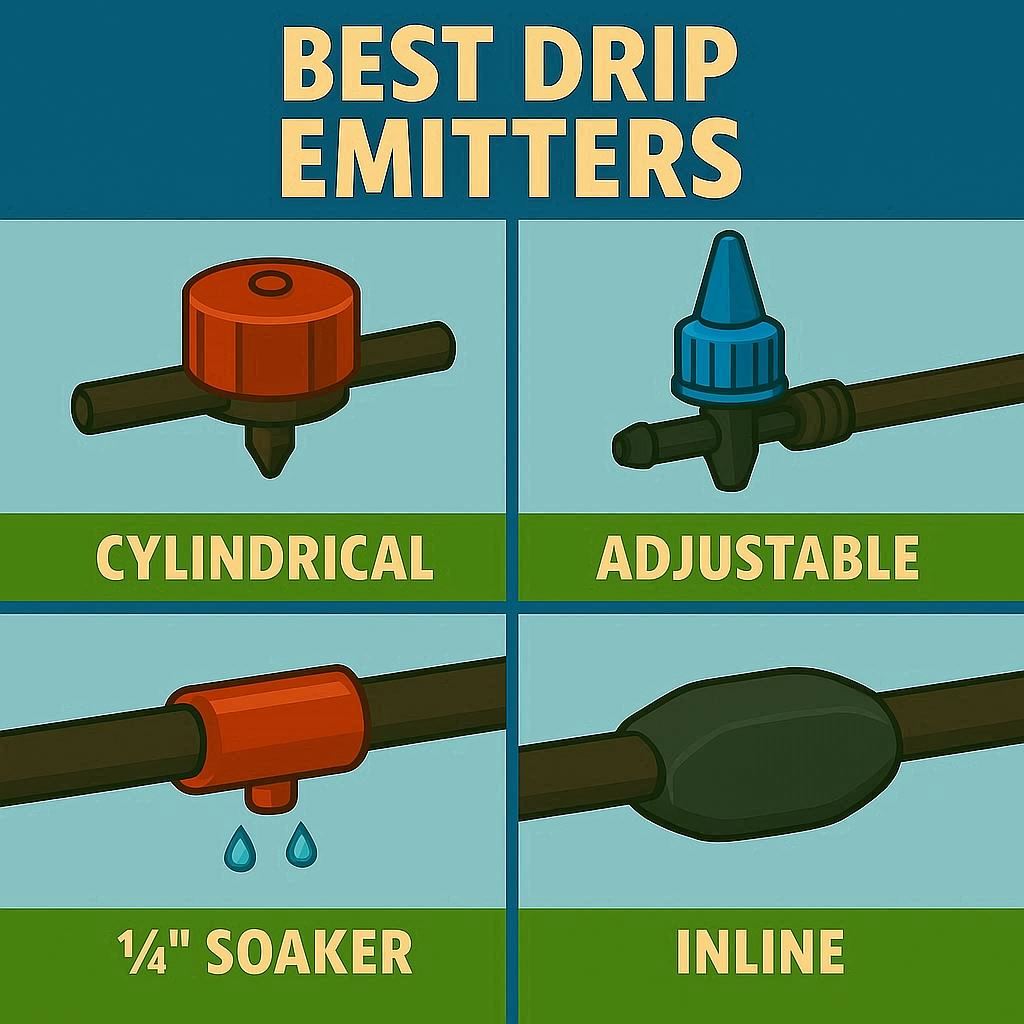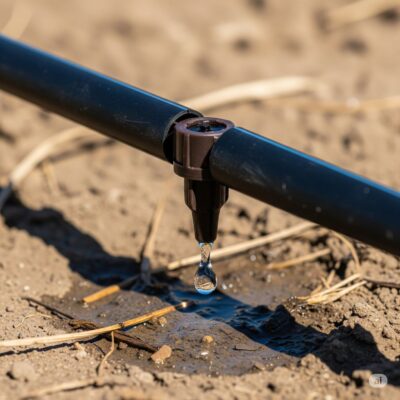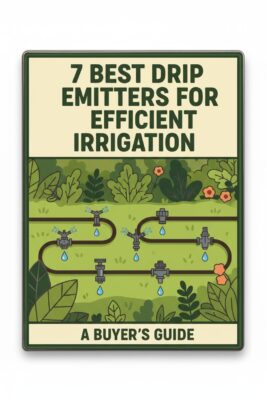
Drip irrigation systems are among the most efficient and water-conserving methods of watering plants, gardens, and landscapes. At the heart of any effective drip irrigation setup is the drip emitter — the component responsible for delivering water directly to the base of your plants. Whether you’re a home gardener, landscaper, or farmer, choosing the best drip emitters can dramatically impact your water efficiency and plant health.
In this article, we’ll explore the top drip emitters, compare their features, explain the different types, and help you decide which is best for your needs.
What Are Drip Emitters?
Drip emitters (also called drippers) are small devices connected to drip tubing or spaghetti lines that regulate how much water each plant receives. They release water at a slow, steady rate, measured in gallons per hour (GPH) or liters per hour (LPH), providing deep and consistent watering.
Types of Drip Emitters
- Pressure Compensating (PC) Emitters
These emitters maintain a constant flow rate even with changes in water pressure or elevation. Ideal for uneven terrain or long rows. - Non-Pressure Compensating Emitters
Flow rate may vary with water pressure. These are generally more affordable and suitable for flat landscapes. - Adjustable Emitters
Allow the user to control the flow rate manually, great for plants with varying water needs. - In-Line Emitters
Built into the tubing itself; used in rows or linear plantings. - Flag Emitters (Take-Apart Emitters)
Easy to disassemble and clean, making them ideal for dirty or mineral-rich water.
Top 7 Best Drip Emitters

1. Rain Bird SW20-30PS Drip Irrigation Spot Watering Emitters
- Type: Pressure-compensating
- Flow Rate: 2.0 GPH
- Best For: Consistent watering in varied terrain
Pros:
- Self-cleaning mechanism
- Maintains even output despite pressure changes
- UV-resistant and long-lasting
Cons:
- Not adjustable
- Slightly higher cost
2. Raindrip R362CT Adjustable Flow Drippers
- Type: Adjustable emitter
- Flow Rate: 0–10 GPH
Pros:
- Ideal for mixed gardens or pots with varying needs
- Easy to twist and adjust
- Affordable in bulk
Cons:
- Susceptible to clogging
- May require frequent adjustment
3. Toro NGE-10PC Drip Emitters
- Type: Pressure-compensating
- Flow Rate: 1.0 GPH
Pros:
- Durable and accurate
- Great for commercial systems
- Compatible with standard tubing
Cons:
- More expensive
- Not adjustable
4. Netafim Woodpecker PC Dripper
- Type: Pressure-compensating with anti-siphon
- Flow Rate: 0.5, 1.0, 2.0 GPH options
Pros:
- Anti-drain and anti-siphon features
- Industry-standard reliability
- Great for greenhouse and orchard systems
Cons:
- Higher price point
- Needs pressure-regulated systems
5. Orbit 69500 8-Port Drip Manifold
- Type: Multi-outlet adjustable
- Flow Rate: 0–20 GPH per outlet
Pros:
- Waters up to 8 plants at once
- Each outlet is adjustable
- Great for container gardening
Cons:
- Needs additional tubing and emitters
- Not ideal for large areas
6. DIG 1 GPH Flag Drippers
- Type: Take-apart dripper
- Flow Rate: 1.0 GPH
Pros:
- Easy to disassemble and clean
- Cost-effective for large gardens
- Long lifespan
Cons:
- Not pressure-compensating
- Slight variance in output in uneven pressure
7. Chapin 5010 Drip Irrigation Emitters
- Type: Non-pressure compensating
- Flow Rate: 0.5 GPH
Pros:
- Budget-friendly
- Great for flat surfaces and low-pressure systems
- Works well in small vegetable gardens
Cons:
- Flow rate affected by pressure
- May clog in silty water

How to Choose the Best Drip Emitters
When selecting the right emitters for your system, consider the following factors:
1. Water Pressure
- For systems with varying elevations or inconsistent water pressure, pressure-compensating emitters are a must.
2. Plant Type
- Use adjustable emitters for gardens with mixed plant types and varying water needs.
- Use standard fixed emitters for row crops or uniform plantings.
3. Clogging Potential
- Choose take-apart or flag emitters if using hard or debris-laden water.
- Consider using a filter and flushing system for longevity.
4. Flow Rate
- Typical flow rates range from 0.5 GPH to 2.0 GPH.
- Low-flow emitters (0.5 GPH) are ideal for succulents and low-water plants.
- High-flow emitters (2.0+ GPH) are better for thirsty plants like tomatoes or shrubs.
5. Ease of Installation
- Barbed emitters easily push into tubing.
- Multi-port manifolds are best for container gardens.
Installation Tips
- Pre-soak the tubing in warm sun to make it easier to puncture and insert emitters.
- Use a hole punch tool for precise installation.
- Install filters and pressure regulators to avoid clogging and emitter damage.
- Periodically flush the lines and check emitters for debris.
- Label or map emitter flow rates for easier troubleshooting later.
Pros and Cons of Drip Emitters
| Pros | Cons |
|---|---|
| Water-efficient | Prone to clogging without filters |
| Customizable per plant | Can be labor-intensive to set up |
| Reduces fungal issues by keeping foliage dry | Emitters may degrade under harsh UV |
| Works well with timers | Requires maintenance and flushing |
Recommended Products Quick List
| Product | Type | Flow Rate | Best For |
|---|---|---|---|
| Rain Bird SW20 | Pressure-Compensating | 2.0 GPH | All-purpose |
| Raindrip R362CT | Adjustable | 0–10 GPH | Mixed gardens |
| Toro NGE-10PC | Pressure-Compensating | 1.0 GPH | Landscapes |
| Netafim Woodpecker | Pressure-Compensating | 0.5–2.0 GPH | Commercial use |
| Orbit 69500 | Adjustable Manifold | 0–20 GPH | Pots & containers |
| DIG Flag | Take-Apart | 1.0 GPH | Easy maintenance |
| Chapin 5010 | Non-PC | 0.5 GPH | Budget gardens |
Drip Emitter FAQs
Q: How many emitters do I need per plant?
A: For small plants, 1 emitter is sufficient. For shrubs or trees, use 2–4 emitters spaced evenly around the root zone.
Q: Can I mix different emitter flow rates in one system?
A: Yes, but ensure uniform pressure and use a pressure-compensating system if necessary.
Q: How long should I run my drip irrigation system?
A: It depends on emitter flow rate and plant needs. For example, 1 GPH emitters running for 30 minutes deliver 0.5 gallons of water per emitter.
Q: Do emitters work with rain barrels or gravity-fed systems?
A: Yes, but use non-pressure compensating emitters and ensure at least 2–3 feet of elevation for adequate flow.
Q: How often should I replace drip emitters?
A: Quality emitters can last 5–10 years with proper maintenance. Replace clogged or cracked units as needed.
Final Thoughts
Choosing the best drip emitter depends on your garden layout, plant needs, and water source. For long-term reliability, pressure-compensating emitters like those from Rain Bird or Netafim are ideal. If you’re on a budget or have a simple flat garden, flag emitters or adjustable drippers work well.
A well-designed drip system with quality emitters will save water, lower utility bills, and keep your plants healthier — with less effort and more efficiency.

I’m David man behind Lawn Mowerly; I’ve been dealing with lawnmowers and Tractors with my father since I was a kid. I know every make and model and what each one is capable of and love helping people find the perfect equipment for their needs.
